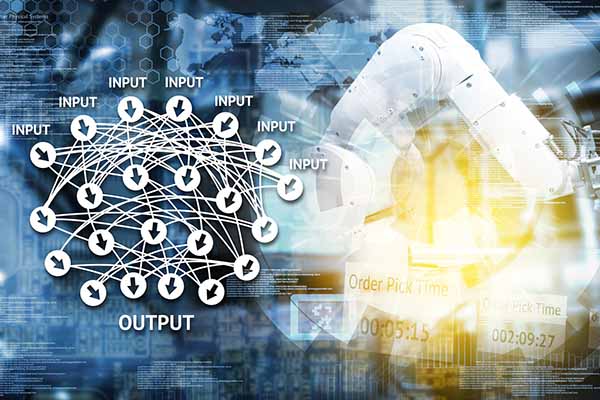It is a concept that is at the core of industrial manufacturing. From the second Industrial Revolution to the rise of Lean Manufacturing, industry giants have optimized the manufacturing process. They realized that removing inefficiency and waste from the process enables them to make more components without changing much else. This approach is the premise of the Toyota Production System, which strives to provide Just-in-Time (JIT) production while minimizing inventory and batching. The process approach is founded on the idea that while an Ideal State of 100 percent efficiency is not achievable in practice, the pursuit of and movement toward the Ideal State is valuable. Taking steps to reduce errors, eliminate redundant and wasted activities, and increase output helps better meet customers’ needs while decreasing the cost of production.
What is Deep Learning
Robotics—a relatively modern industry and technology—has roots dating back to the industrial 1920s and enhanced over time. For example, the Westinghouse Electric Corporation had a robot called Televox that could respond to a human voice and perform simple tasks. Today, far more complicated and even dangerous tasks employ robotics.
Today, the manufacturing industry is surging through Industry 4.0, implementing new technologies and approaches as transformative as those from the past. With connected devices expanding the Internet of Things (IoT) and 5G rollout out to an ever-wider coverage area, deep learning leverages those technologies with robotics and artificial intelligence (AI) to apply them to manufacturing.
An article in the Journal of Manufacturing Systems defines deep learning as how engineers use comprehensive analytic tools to process and learn from big data. In other words, the machines learn what the operators want them to do and how they should change. This approach yields “smart” manufacturing by incorporating advanced analytics into enhanced decision-making and system performance opportunities. These additions greatly extend the manufacturing process beyond anything that has come before. They help move further toward the Ideal State of JIT manufacturing defined by Toyota.
Deep learning applies to specific applications like predictive maintenance, analytics to drive predictive steps for process improvement, product development (to predict the manufacturing impact of design decisions), quality assurance, and supply chain/logistics. The approach’s benefits provide substantially more than the sum of its parts; they create new areas of efficiency while offering greater flexibility and adaptability to changes to products and processes. The technology also helps with supply chain disruptions uncovered and exacerbated by the pandemic: capacity utilization and production deficits.
How Manufacturing Sites Incorporate Deep Learning
With the principle of deep learning defined, the key question is how to employ this transformative approach into plants to improve manufacturing performance. Because there are significantly fewer manual steps, incorporating deep learning may require changing the philosophy and flow of the plant layout through multiple layers of integration:
- Horizontal integration through operational systems
- Vertical integration through connected manufacturing
- Holistic integration through the end-to-end value chain
Many call the resulting workstyle “smart factories.” With these integrated pieces in place, the equipment automatically sends the output of one process as the input to the next. Reducing the process change and transition time is the critical difference.
World-leading companies are already employing this new strategic technology, such as Whirlpool, Siemens, Hirotec, and Hewlett-Packard. The transition is not easy, and it requires companies to commit and invest in the capital, training, and support to realize the seismic shift. The investment is a smart one, though: McKinsey suggests deep learning applications in manufacturing and supply chains could add an incremental annual revenue of $1-2 trillion.
Though the investment and mindset are significant, the technology uses and improves existing processes, optimizing them upon deployment. Engineers can collect the data by adding sensors to collect the current-state information. These set the baseline for defining where to improve the process. The finer the grid of data collected, the better the predictive models can regress the performance and propose improvements.
A case study is Westinghouse’s Televox robot. Today, the robot can take on more complex tasks with the addition of predictive technology. And with the application of deep learning, this robot can also teach itself to identify and perform new tasks, taking optimization to a whole new level. In addition, the improvements to the robot’s workflow can remove a previously manual task, freeing up the operator to perform a more specialized job. This example is one way deep learning can positively impact the manufacturing process, improving consistency/reducing errors while better deploying human capital.
Takeaway
Industry 4.0 is in full swing, and the IoT, 5G, and AI are fueling immense progress in manufacturing. By leveraging deep learning, manufacturing innovation will meet technology innovation to power the industry forward like never before.
About the author:

Adam Kimmel has nearly 20 years as a practicing engineer, R&D manager, and engineering content writer. He creates white papers, website copy, case studies, and blog posts in vertical markets including automotive, industrial/manufacturing, technology, and electronics. Adam has degrees in chemical and mechanical engineering and is the founder and principal at ASK Consulting Solutions, LLC, an engineering and technology content writing firm.















